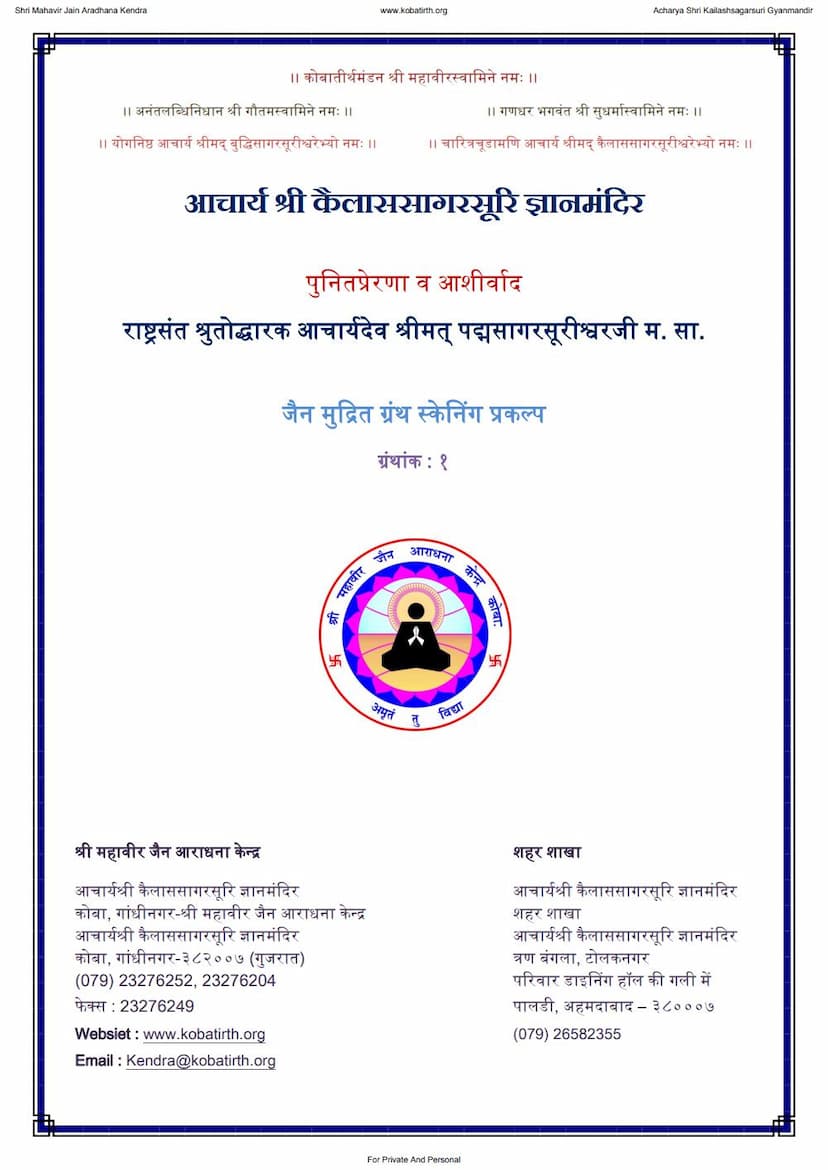Vipak Sutram
Added to library: September 2, 2025

Summary
The provided text is a Jain scripture titled "Vipak Sutram," authored by Gyanmuni and Hemchandra Maharaj, and published by Jain Shastramala Karyalay. The text, cataloged as 020898 on jainqq.org, is presented with commentary and translation in Hindi by Shri Gyanmuni Ji Maharaj, with research by Pandit Shri Hemchandra Ji Maharaj. The publication is part of the Jain Shastramala, dedicated to promoting Jain scriptures.
The text appears to be a detailed commentary and translation of the Vipaka Sutra, one of the Agam scriptures in Jainism. The initial pages (1-15) contain introductory material, including blessings, acknowledgments, publisher's notes, and a biographical sketch of Muni Shri Shaligram Ji Maharaj, to whom the book is dedicated. Muni Shri Shaligram Ji Maharaj is described as an ideal Muni, born in Samvat 1624, who lived a life of renunciation and was a devoted follower of Jain principles. He was instrumental in inspiring the translator, Shri Gyanmuni Ji Maharaj, towards the path of Jainism. The text also highlights the efforts of the Jain Shastramala office in translating and publishing Jain Agams into Hindi for wider accessibility.
The latter part of the provided text (pages 16 onwards) delves into a detailed exposition of the "Karma Mimansa" (an analysis of karma) and then proceeds to the "Shri Vipak Sutra" itself.
Key aspects covered in the text include:
- Theological and Philosophical Concepts: The text elaborates on Jain philosophy, particularly the concept of karma, its various types (jnānāvaraṇīya, darśanāvaraṇīya, vedanīya, mohanīya, āyu, nāma, gotra, antarāya), their sub-types, and the causes for their bondage. It discusses the nature of the soul, the universe, suffering, liberation, the cycle of birth and death, and the principles of Ahimsa.
- Vipak Sutra's Content: The Vipaka Sutra itself is described as the eleventh Anga (limb) of the Jain Agamas. It is divided into two parts: Duskhavipaaka (fruits of negative karma) and Sukhavipaaka (fruits of positive karma). Each part contains ten chapters, narrating historical accounts of individuals who experienced the results of their past actions. The text emphasizes that the Vipaka Sutra uses narratives to illustrate the intricate workings of karma, guiding individuals towards righteousness and away from sin.
- Karma Theory: The text extensively explains the Jain theory of karma, including its eight main types (prakṛtis) and their 158 sub-types (uttara prakṛtis). It details how karma binds the soul and influences its experiences of happiness and suffering. The concepts of āśrava (influx of karma), bandha (bondage), saṃvara (stopping of karma), and nirjarā (shedding of karma) are implicitly or explicitly touched upon.
- Biographical Sketches: The text includes a brief biography of Muni Shri Shaligram Ji Maharaj, the dedicatee, highlighting his virtuous life and influence. It also mentions the role of Gurudev Shri Ātmaram Ji Maharaj as the inspiration for the Hindi translation.
- Structure of the Text: The provided pages include a detailed index (Viṣayānukramaṇikā) outlining the contents of the first few chapters (Adhyāyas) of the Vipaka Sutra, specifically focusing on the "Duskhavipaaka" section. These chapters detail the past lives and consequences of actions of various individuals like Mrigaputra, Ujjhitaka, and others, illustrating the principles of karma.
- Commentary and Explanation: The Hindi commentary ("Ātmajñānavinodinī") by Shri Gyanmuni Ji Maharaj aims to simplify the complex philosophical concepts and narratives of the Vipaka Sutra, making them accessible to a wider audience. It also provides explanations of difficult terms and verses.
- Svadhyaya (Self-Study) Rules: The text also touches upon the rules of Svadhyaya, including specific times when scripture study is not permitted (Asvadhyaya periods), listing 32 such times.
In essence, the provided text is a significant Jain scripture that aims to elucidate the profound principles of karma and its consequences through narratives, thereby guiding the reader towards a virtuous life leading to spiritual liberation. The commentary makes the ancient wisdom of the Vipaka Sutra understandable for Hindi-speaking audiences.